Tiger Woods' golf swing is a swing that is marveled by all. We all think to ourselves, "If my swing just looked like his, I'd be on the PGA Tour." Let me assure you, you wouldn't! How do I know? Let's take a look.
Over the past 6 months, I spent a great deal of time learning Hank Haney's swing methodology that he has taught Tiger Woods.
I did this primarily to educate myself to become a better instructor, not to become a better player. During this time, my golf swing went through a significant metamorphisis that you can see below. From the face on view below, my swing matches up quite well with Tiger's golf swing.
The interesting thing to note is that while my swing looks a lot like Tiger's, it certainly doesn't hit like Tiger's. Not that I'm a horrible golfer, I'm a plus 3 handicap at Castle Pines Golf Club in Colorado as the Teaching Professional there.
But the focus in this video is to demonstrate that static positions are useless without properly performing the movments of the body that create these dynamics. The dynamics in the golf swing are what make the difference between being the best in the world and a decent golfer.
Sadly, most golf instruction these days is focused solely on learning positions that can only be achieved by using the correct muscles in the correct sequence. In other words, trying to learn certain positions in the golf swing statically is a complete waste of time as they can only be achieved when you understand how to move your body correctly, which is exactly what the Rotary Swing Tour Learning System is all about.
1. Tiger Woods - Chuck Quinton Address Position
From the address position, we're practically identical, so much so, that in the overlay on the left you can't even tell us apart. Heck, I'm even wearing a Nike hat. Looks like all systems are go for takeoff.
The main difference you can note is that my left shoulder is "hiked up", out of the box in Rotary Swing terms. This is not a good position to be in and will come into play later on.
2. Tiger Woods - Chuck Quinton Takeaway
Our takeaway and early backswing positions are once again, basically identical. The only difference that you are starting to be able to see is his left hip is sticking out just past mine as I have slightly more early hip turn. My right arm is also sitting higher than Tiger's, you can note the space between my two forearms.
This stems from my setup position of being "out of the box" as that typically indicates that a golfer is going to "push" the club back with the left side rather than pull with the right (watch the Push vs. Pull video for more info).
3. Tiger Woods - Chuck Quinton Backswing
Still matching up at this point, the only thing noticeable is my hips have turned slightly more as you can see slightly more of his left leg.
Creating a stable base is critical in the golf swing, and posture is vital for this. Learn how to setup properly to the golf ball by watching our "Biomechanically Correct Posture" video.
4. Tiger Woods - Chuck Quinton Top of the Swing
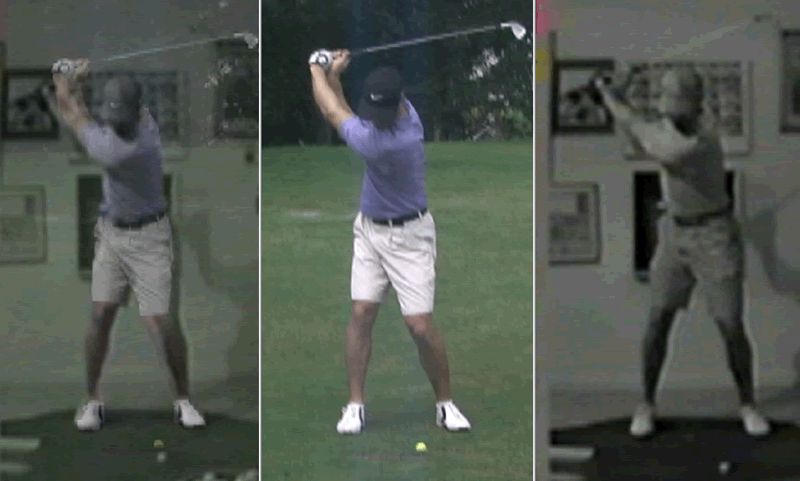
At the top of the swing, Tiger is slightly shorter and has slightly less hip turn. Because I pushed from the left side off the ball and didn't have a proper setup, my left side has collapsed here a bit which will make harder to get to my left side in the downswing.
5. Tiger Woods - Chuck Quinton Downswing
On the downswing, we're once again, extremely close, but there are some differences that start to show up and these make all the difference in the world.
Obviously, Tiger Woods' dynamics in his golf swing are amazing. No one uses their body as well as he does and as explosively and powerfully while maintaining incredible control and balance and you can see that demonstrated here.
Tiger has a lot of lateral movement during the transition in his golf swing, making an assertive and necessary move to the left side. You can also see this in my golf swing. We are both moving similar amounts, but he had a head start.
If you remember during the backswing discussion, Tiger didn't rotate his hips back as much as I did and this gave him the jump on me here. The last thing of important note is that Tiger's shoulders are still slightly more closed to the target than mine.
You can detect this by looking at his right shoulder. Note how you can see more of right shoulder and his is still behind his head. The is indicative of my pushing from the right side while Tiger is pulling the club back down with his left side.
6. Tiger Woods - Chuck Quinton Impact
Ahh, the moment of truth. Everything Tiger and I did in the golf swing was designed solely to bring us to this point and once again, the positions are very similar.
The main difference is my frame is a split second after impact and Tiger's is a split second before. My camera is also set slightly lower, thus the different appearance of the ball position. While our still frames look practically identical, it is how we transverse from frame to frame that makes our golf swings what they are.
In the video, you can see how our dynamics differ that make the difference between being a champion like Tiger Woods and a good player like myself and see how to improve your dynamics to make you a better ball striker.
If you would like to look at Tiger Woods swing even more in depth, please visit my Tiger Woods New Swing with Hank Haney page.
Video Transcription: Tiger Woods Swing Dynamics
I told you guys that I would do a video on the dynamics of the golf swing, because I realize a lot of you guys don't understand what I'm referring to when I use the word "dynamics," that a golf swing is very dynamic, that his dynamics are good or bad, or those types of things.
The more I thought about this, the more I realized how difficult this was going to be, because the dynamics of the golf swing are not something that are really easily defined, because they're dynamic, and by the very definition, they're always changing.

Tiger Woods - Setup
One person's dynamics are obviously going to be different than another's, but what I want to do with this video is, one, try to give somewhat of a definition of dynamics in the golf swing, and try to explain the importance of the dynamics because at the end of the day that's what it really all comes down to.
I found a couple of definitions that help define what we're talking about. One of the definitions I found is that "Dynamics is the branch of mechanics that is concerned with the effects of forces on the motion of a body or a system of bodies, especially of forces that do not originate within the system itself."
That definition is the best one that I've found. While it doesn't make a lot of obvious sense, it's a pretty appropriate definition for the dynamics in the golf swing.
I'm going to walk you through a few swings here. We're going to start with this one of Tiger Woods on the right here.
I've drawn these lines to represent where Tiger's going to be at impact. What's interesting is obviously during the setup it's a pretty static position. You can see Tiger's setup. Obviously, he's not moving when he's set up to the golf ball.

Tiger Woods - Top
He might move just before he pulls the club back, but for an instant he's pretty close to being completely static here.
What's amazing about a golfer with good dynamics in the golf swing is that their impact position, their backswing, downswing positions, are drastically different than their setup positions, which means that a golf swing would have to be very dynamic.
Otherwise, it would have to be changing. The impact position doesn't originate within the system itself, by using that definition. Obviously the system that we're talking about is the golf swing, and the positions that we're referring to are the setup positions.
You can very clearly see where Tiger's set up here, but what's interesting is the lines that I've drawn actually represent important positions in his impact.
If I told you this red line was going to represent his spine angle at impact, would you believe me? Well, it's true. These blue lines represent where his head's going to be at impact, and this green line represents where his hips are going to be.

Sitting into the left side
His hips haven't moved a tremendous amount during the downswing, but a lot of his body has. There's no way that you rehearse these positions, per se, in a static fashion. These are only achieved throughout the dynamic, changing forces of the golf swing. As we walk through his golf swing, you're going to start to see some pretty amazing events transpire.
As we get to the top of the swing, everything's stayed pretty constant here. He's made some hip rotation, a very small amount of lateral movement, very, very small. He's moved off that line just a touch more, but now what's amazing is his spine angle still stayed constant. His head stayed about where it was at address, but now watch the dynamics take over.
From here, you get that transition move. The transition is the most dynamic motion in all of golf, because as the club's still going back, he's starting to settle into his left side. You can see that if you watch very closely.
He's starting to get back into that left side. You can see his legs really starting to power, to get his body back going left. It's a very dynamic motion, because at the last instant his club is actually still traveling backwards as he's moving more into his left side.

Left hip gets into line
Now this is where the dynamics really take over. At this point, it's all set in motion. There's nothing he's going to do to change this. He's simply going to let everything fire through, and the dynamics of the golf swing are going to take place.
Notice how we start to get into that green line with his left hip. His head's moved forward a little bit. It's going to start to actually move backwards. Now that red line at impact, right through his belt buckle, right through the center of his chest.
[4:56 - Overlay] He has changed from where he was at address, if we go back there...now these angles don't seem quite so crazy. If we do an overlay of it, as he comes down into impact, you can see just how dynamic this position is.
His arms and his hands were here at address, and at impact his hands have moved higher, they've moved much farther forward, his arms are at a completely different angle, and his head's actually moved backwards and down several inches.

Overlay of address & impact
This is a very dynamic golf swing. The dynamics of Tiger's golf swing are what give you the synergistic effects, where you get 1 + 1 = 3. Tiger's swing is constantly changing. It's stretching muscles, releasing muscles, and doing things very dynamically that give him a lot of extra power in his golf swing.
It's not a golf swing where you're sitting there looking at it, "Oh, his swing looks really contrived and controlled," or "He looks like he's trying to manipulate the club on the way back." It's a dynamic motion, through and through.
All of the positions that he achieves - and this is what it all comes down to at the end of the day - is that the positions that you achieve, particularly in the downswing, should be 110% exclusively because of the dynamics in your swing.
If you're getting into positions because you're trying to manipulate them, you're losing a ton of power in your golf swing, and you're losing the essence and the freedom and the flow of the golf swing.
Tiger's not sitting here trying to get his hands forward per se. Now, granted, there's training and stuff that's involved here with learning these proper impact positions, but at address he's obviously setting himself up not exactly in the impact position.

Chuck - Top of swing
It's very different from where he was at address, but the dynamics of his golf swing change all these positions and get him into a powerful position at impact.
If we look at my swing here on the left, another thing we can talk about is the transition, and also the downswing. As I get to the top of my swing - right there is about the top - notice how the club is going to actually start to move left - you can see it right there at the top - it's actually moving away from me and away from the target line.
It's a very dynamic thing that's happening. You see this in most all the Tour pros, that their club head actually starts to fall away from them. This is something that a lot of instructors actually try and teach the golfer how to do. It's a dynamic thing. It's not that I'm sitting here at the top of my golf swing and saying, "OK, I'm going to make that club head fall away from the target line and go back around behind me."
I couldn't possibly think that, and if I did it wouldn't be a dynamic motion. It would be a controlled, manipulated motion.
As that club head starts to fall away, it's simply a result - if you look at the rest of my body, my arms aren't doing anything, my hands aren't doing anything - but I'm starting to settle into that left side and starting to drive with my body.

Chuck - Shaft through forearm
I'm getting into my left side. I'm using my legs, I'm using my core, and that's pushing that club back behind me. It's getting my arms farther back behind me as I come down, because of my body motion, not because I'm directly manipulating something with my hands. I'm not directly manipulating the golf club.
The same thing is true as we come farther down into the downswing. One of the things I just did a video on is this position here, this shaft through the right forearm. This is not a position that I achieved statically.
I can achieve static positions in my address position and partly in my backswing, although I'd like for that to be very dynamic as well, but in the downswing I have no direct control over this. This simply happens. There's no way that I'm every trying to get this club over my right forearm. It simply can't happen. It has to happen as a result of all the other dynamics in the golf swing.
In honesty, this is a huge part of what makes learning how to play golf so difficult, because the golf swing cannot be learned as a completely static motion. It has to be understood that there are dynamic forces at work that generate these positions.
This is a fantastic position here. The farther you can get this club head back behind your body at this point, going through that right forearm, the more power you're going to have and maintain a lot of lag here.

Chuck - Impact
I'm in a perfect on-plane position as I come down into impact, but this is not something I can statically try to produce. It simply has to happen as a natural force of the dynamics in the golf swing. Same thing as I come down into impact. Everything's already been set in motion here. Then as I release it, it's all dynamics at this point.
Another golf swing I want to look at, Adrian Wadey. He has, probably out of all the golfers that I know, the most dynamic golf swing of any human being I've ever seen. He has so many amazing forces at work and he's hands-down the best ball striker and the most powerful, consistent ball striker I've ever seen, and that includes all the Tour pros that I've ever seen and worked with.
Hands down, he's the best ball striker I've ever seen and his golf swing, position wise, is certainly not as picture-perfect as Tiger Woods, as somebody who's very conscious of mechanics and positions and plane angles and forearm rotation and club face angles and all these things.
To be honest with you, Adrian doesn't know a lot about this type of stuff. He just knows how to hit a golf ball. When you look at his golf swing and we talk about...this video of him here is right before he finished, I believe, third or fourth in the Utah Open. He shot a 66 the last day.

Adrian Wadey - Setup
I was working on his golf swing with him out in Utah, and he has very little idea of exactly what's going on in his golf swing. He doesn't need to, because his dynamics are so incredibly good. As you'll start to see here, in this golf swing, the things that he's doing here are what produce his powerful ball striking.
I've drawn a couple of lines here to show some changes that happen throughout the swing. Notice his chest basically sits on this red line here. I'm going to change the color of this one to make it yellow. This is his shaft plane.
Notice, as he takes the club back, even just to start the golf swing it's probably one of the most dynamic starts to a golf swing. People always ask, "What moves first? Should I move my club head first or my hands first?"
I want you to pay close attention. I'm going to zoom in here a little bit so you can see this a little bit closer. I want you to pay very close attention to what moves first in his golf swing.

Adrian - Top
The club head hasn't moved yet, but you can see a ton of body motion before the club head ever is taken away. His head has moved, his arms have moved, his hips have moved, his knees have moved, his feet have moved...and the club hasn't moved.
This is an incredibly dynamic start to the golf swing. He's getting his whole body in motion. Everything is moving here. This is really a phenomenal thing to watch, especially when you look at some golfers who are much more manipulative and slow and controlled with the takeaway.
He's trying to be as dynamic as possible. He's trying to get that freedom and that flow and that rhythm in his golf swing right from the outset.
As he takes the club back - let me zoom out here just a touch - this position at the top is something that we were working on, trying to get him a little bit more around and a little bit more laid off at the top before he played in the tournament, but obviously we didn't get too crazy about it. Adrian's just not a position-oriented golfer, and he doesn't need to be.
Some of the things that were going on in his golf swing were causing him some issues, but his dynamics are so good that they make up for it, so you don't really worry about it.

The club head falls back
If his position is a little steep here with the arm, and the club face is a little shut, wrist is a little flat, whatever, as long as his dynamics work in his golf swing, and they do. Here you can really start to see something in his golf swing.
As he starts back down, notice how, from where he is at the position here you can see the club head between his arms. Notice how much that club head falls back away from him. His club head is now moved two feet, way back behind him.
This is not something that he's consciously doing. It's that his body - notice his knees and his hips and his core, and his head - everything's starting to get going back left. You're going to see a tremendous amount of body movement as he starts back down.
Watch his belt. Notice how his belt, his knees, his hips, everything is driving back around. Right here he's just slightly steep above his forearm, but it's less steep than it looks. We just talked about it in this video, where the shaft should cover the right forearm.

Slightly steep
Adrian maintains a tremendous amount of lag, and if you have a lot of lag in your golf swing, at this point in the golf swing where your hands are starting to get into this position back down the target line, it can look like the shaft is a little bit steep but it's strictly because he has a ton of lag and he's not coming in very shallow.
He actually hits a little bit of a cut on all of his drives, which is pretty nice, hitting the ball 330 yards, to be able to play a cut. That's why he looks like he's just a little bit steep here.
As he comes down, notice how much his body has rotated already, from the top. His hips have rotated a tremendous amount. As he comes into impact his hips are almost square to the target, and his shoulders are very open to the target, and then he releases the club through.
I'm going to play this swing back a couple of times - I'll delete these lines on here - so you can watch just how dynamic and powerful this golf swing is. It looks like he puts very little effort into it, but I measured his club head speed and he had 121 miles an hour. Trust me, there's some speed and power being generated there.

Lots of rotation
You can see just how flowing and dynamic his golf swing is. It's a very, very simple movement, but it's very complex in the same sense that if you're trying to copy his golf swing, you're looking at all these different movements that are going on, just before he even starts the club back. He's got his whole body in motion.
This is the thing you take away from this, is understanding that the golf swing is a living force. It's a constantly in-motion, dynamic action. It's a dynamic system. Everything's got to be flowing, and the more tight that you get...
When you get in tournament situations, or pressure situations, and your swing gets tight and you hit terrible shots, and then you step up there and you hit one OB and you're all tight and you're like, "God, I can't believe I did that," and you step up there and put another ball down and you just step up there and rip it...your swing is freed up on that second shot. It's much more dynamic.
If you look at them on video, you can see it in a golfer. You can see when they're being controlled and tight, and trying to control and manipulate the club head, and you can see a golf swing like this, where it's just all systems are go and I'm just going to let everything rip through and my body's all flowing and in motion. Then you can pound the ball.

Adrian - Driver setup
Take this away from dynamics: that the more dynamic your golf swing is, the less you have to worry about positions. Positions are important, but the beautiful thing about having a very dynamic golf swing is that the more dynamic it is, and the more fundamentally correct it is, the easier it is to get into these proper downswing and impact positions.
I want to look at one more video of Adrian from face on. Let's see if I have a driver in here of him...there we go.
We'll look at his driver swing from face on, and you'll see the same things going on here, the same dynamic motions.
His swing will look very, very flowing and effortless because of how dynamic his swing is. Even his setup is dynamic. As he gets into the ball, as soon as he sets the club down and he's ready to go, notice how much movement there is still going on here.
He's starting to settle into that left side a little bit more. This motion alone is just something you could study for hours. It's something that you can't explain, but you can see it going on, that his hips are actually moving toward the target before he pulls the club back, and the arms are moving back in a different direction.

Adrian - Top
Then he gets everything synced up. There's a lot of movement here, but it's all good movement. It's dynamic movement. It's getting that club to go back, and you can see as he takes it back, the club head is actually bowing backwards during his takeaway. This is an x-flex shaft, and I hit it - trust me, it's very stiff. That's how dynamic his golf swing is.
He's getting the club head and the arms and everything moving in the proper sync to get everything flowing back. He's actually moving that club back completely with his body, and that club head is just kind of staying still, but his body's moving. That's going to stress the shaft.
Even at such a slow speed - you'll see it's actually pretty quick, once you watch it in full speed - everything's moving here. Just in the takeaway, everything's alive. It's moving, it's all dynamic.

Adrian - Impact
As he gets to the top of his golf swing, watch how everything starts to settle back into the left side, and then you're going to see the same thing that you see in all great ball strikers. The head's going to go down, it's going to go back, and his spine angle is going to get that axis tilt at impact.
I'm going to draw a line here from his belt buckle to the top of his spine. You can see that's where he is at impact. It's a tremendously dynamic and different position. If you look at an overlay, you can see just how different it is as he comes down into impact.
His head's moved back and down a good six inches to get into that position, but his hands, just like Tiger's, have moved forward a good six or eight inches. I'm not going to talk in detail about this whole axis tilt bit, getting your left wrist flat. It's an important topic, but it warrants a video completely on its own.
The thing is, you would see this golf swing and think, "Oh, everything's got to be really constant in the golf swing." That's one of the misconceptions about what we're doing in a one plane swing. Yes, we're definitely trying to keep things more constant. We're trying to keep the spine angle more constant, the base of the spine, those types of things.

Adrian - Overlay
But in any good golf swing, these positions all change dynamically. Even in a one plane swing, your body's got to be moving. That spine angle is going to change dynamically during the downswing. Obviously, you don't want to do something to manipulate that and make it change. During the backswing these things stay constant, but during the downswing it's got to be dynamic.
As soon as that transition happens, it has to be a dynamic motion from there on out to achieve proper impact position.
Study these swings. I'll play this one a couple of times so you can see just how free-flowing his golf swing is here.
It's an incredible golf swing. When you watch it at full speed it seems very simple. Watch his address position. The club head's traveling at about, I believe during this day he was swinging about 118 on a normal golf swing, so there's certainly a lot of power here but it's all free-flowing and effortless.
Anyway, study this. Free up your golf swing. Understand that the dynamics in the golf swing are what make it really work. Understand that it's not just all the positions, and static positions. It's achieving these positions dynamically that's going to make you a better golfer.
Watch part 2 now to see how you're moving your body in the opposite direction of the pros!









































































































































































































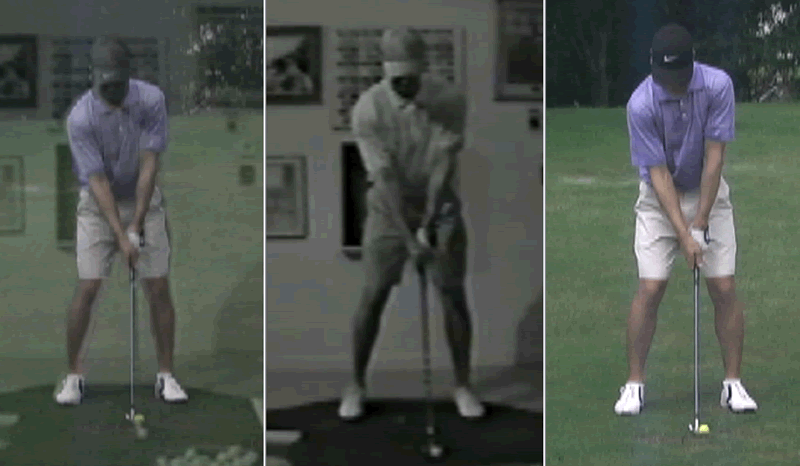
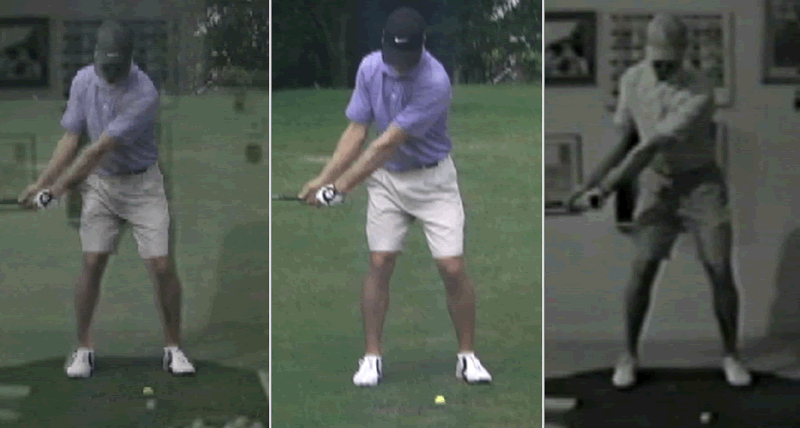
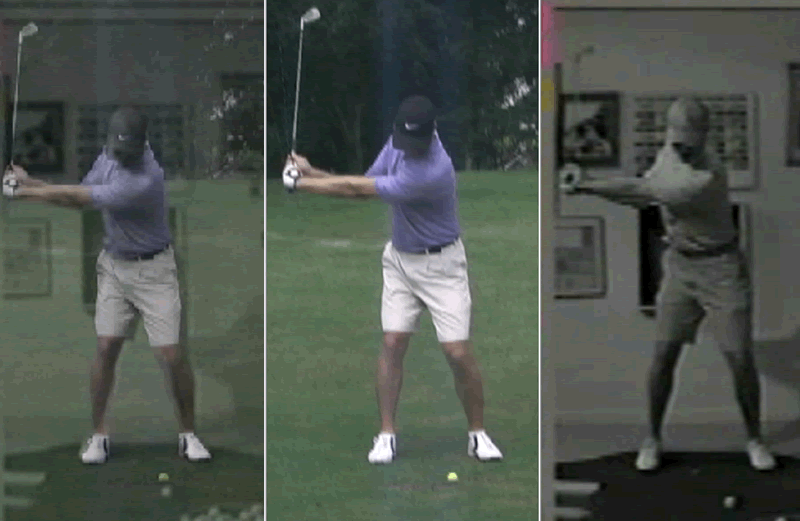

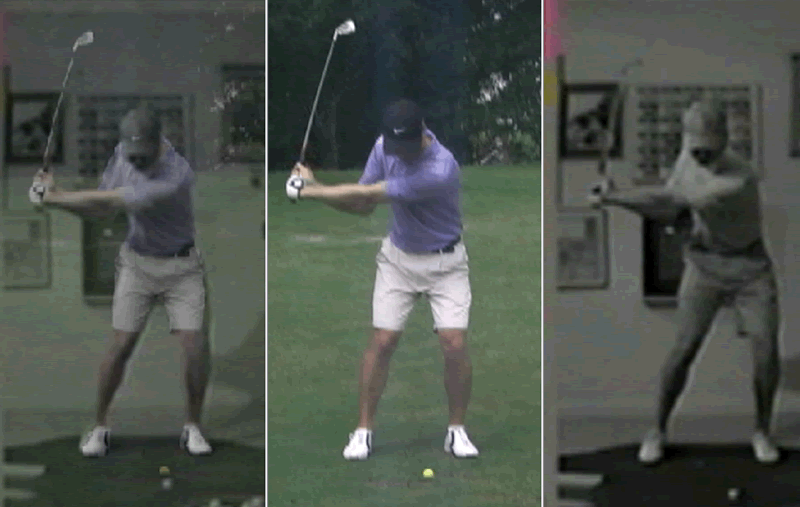
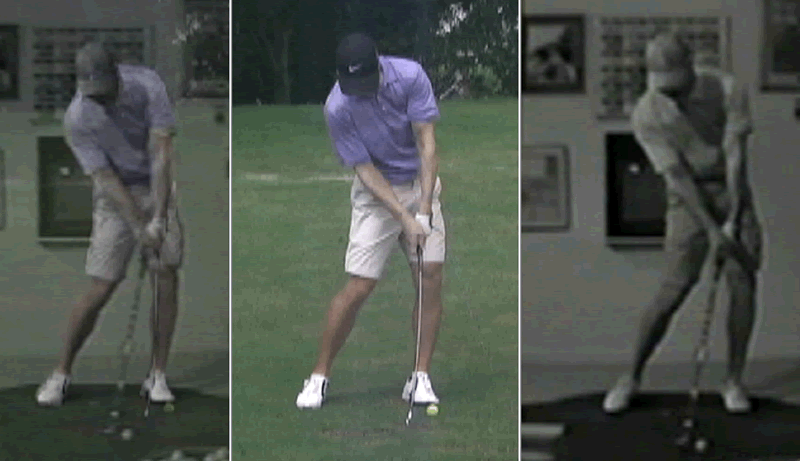
 Tiger Woods - Setup
Tiger Woods - Setup Tiger Woods - Top
Tiger Woods - Top Left hip gets into line
Left hip gets into line Overlay of address & impact
Overlay of address & impact Chuck - Top of swing
Chuck - Top of swing Chuck - Shaft through forearm
Chuck - Shaft through forearm Chuck - Impact
Chuck - Impact Adrian Wadey - Setup
Adrian Wadey - Setup Adrian - Top
Adrian - Top The club head falls back
The club head falls back Slightly steep
Slightly steep Lots of rotation
Lots of rotation Adrian - Driver setup
Adrian - Driver setup Adrian - Top
Adrian - Top Adrian - Impact
Adrian - Impact Adrian - Overlay
Adrian - Overlay
